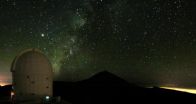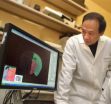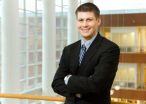(Press-News.org) This press release is available in German.
Whether a quantum object behaves like a wave or like a particle depends (according to the Copenhagen interpretation) on the choice of measurement apparatus used for observing the system, and therefore on the type of measurement performed.
Anton Zeilinger's team of physicists at the University of Vienna and the Austrian Academy of Sciences has recently taken this phenomenon further than ever. Whether a certain photon behaves like a particle or like a wave depends on the measurement performed on a second photon. In the new experiment, this second photon is so far separated from the first photon that no transfer of information whatsoever (the velocity of which can never exceed the speed of light) would be fast enough. Yet, the first photon behaves like a wave or like a particle, still depending on the measurement performed on the second. While the results of such experiments are fully consistent with quantum physics, a clear explanation in terms of causality is impossible, as, according to Einstein's relativity theory, any transfer of information is limited to the speed of light. The science article "Quantum erasure with causally disconnected choice" has appeared in the current issue of the renowned science journal Proceedings of the National Academy of Sciences (PNAS).
The basis: the delayed choice experiment
Gedanken experiments on the foundations of quantum mechanics have a long history. Such thought experiments were developed to play through and discuss the behavior of single particles, which contradict both classical physics and common sense, at least theoretically. One milestone was the 1978 delayed-choice experiment by Einstein's last collaborator John Wheeler. In this gedanken experiment, a single photon has two paths it could take in an interferometer. In its wave character, the photon will take both paths simultaneously. In its particle character, the photon needs to decide which of the two paths it will take. Wheeler proved, in accordance with quantum mechanics, that the decision whether the photon will behave as a wave or as a particle can be taken after even after it has already entered the interferometer.
The quantum eraser
The so-called quantum eraser, presented in 1982 by Marlan Scully and Kai Drühl, turned out to be another milestone. A quantum mechanically entangled pair of one photon and one atom is created. The atom can take two paths, emitting the photon in the process. By measuring the photon, it can now be determined which of the two paths the atom has taken. If we now measure the photon in such a way that it becomes fundamentally impossible to determine the atom's path, as a consequence, the information about which path the atom has taken is, so to speak, erased. The atom then exhibits phenomena which can only be explained by its taking both paths, as a wave.
Vienna quantum physicists turn off the causality factor in experiment
The two ideas, delayed choice and quantum eraser, have been realized in experiment both separately and in combination. In all past experiments, the possibility that the choice of measurement has a causal influence on the actual observation (by transmission of information slower than light) still remained, if only in principle.
In the two new experiments, one of which was performed in Vienna and one on the Canary Islands, this remaining possibility of a causal explanation was now ruled out. The researchers created a pair of photons, one of which was sent through two glass fibers while the other was sent to a different laboratory, 50 meters away in Vienna and 144 km distant on the Canary Islands. The second photon was entangled with the first in such a way that by measuring its polarization (horizontal or vertical), it was possible to determine which path the first one had taken. If the second photon's polarization was measured at 45 degrees, no deduction on the path of the first photon was possible, which then, as a wave, took both paths. The decision of which measurement to perform on the second photon was realized by means of a high-speed random number generator. In both experiments, also in the case of the 144 km long optical free space connection from La Palma to Tenerife across the Atlantic, the choice of polarization measurement at the Tenerife photon was completely separated causally from its twin in La Palma. And yet, the photon on La Palma behaved like a particle or like a wave, according to the Tenerife measurement.
"This rules out the possibility of any physical signal between the two photons. Introducing this non-causal choice is a substantial step beyond existing quantum eraser experiments, where such communication is still possible in principle", explains Xiao-Song Ma, the first author of the current article.
Consequently, the experiment can be seen as a complete realization of the quantum eraser concept, not via delayed choice (which theoretically might be influenced by past events) but using a causally separated choice (by rendering any causal influence impossible).
"Our work disproves the view that a quantum system might, at a certain point in time, appear definitely as a wave or definitely as a particle. This would require communication faster than light – which is dramatically at odds with Einstein's theory of relativity. And so, I think that this view needs to be abandoned completely. In a certain sense, quantum events are independent from space and time", says Anton Zeilinger.
INFORMATION:
News from the world of quantum physics: A non-causal quantum eraser
2013-01-09
ELSE PRESS RELEASES FROM THIS DATE:
Supply problems spark search for new ways to make magnets -- not the 'fridge' variety
2013-01-09
Mention magnets, and most people think of trivial applications of those pieces of metal, like holding family photos and reminder notes on the refrigerator. An article on magnets in the current edition of Chemical & Engineering News (C&EN), however, focuses on the critical role magnets play in the real world and the search for new materials to make them. C&EN is the weekly newsmagazine of the American Chemical Society, the world's largest scientific society.
In the article, C&EN Senior Correspondent Mitch Jacoby explains that magnets are crucial to an enormous number of ...
Why are children at higher risk for negative health effects of environmental toxins?
2013-01-09
New Rochelle, NY, January 9, 2013—More than 85,000 synthetic chemicals are registered for commercial use with the U.S. Environmental Protection Agency (EPA), and only about half of those produced in large quantities are tested for their potential toxic effects on humans. Children are particularly vulnerable to environmental toxins and a detailed look at how and why, and what can be done to protect children's health, is presented in a two-part article published in Alternative and Complementary Therapies from Mary Ann Liebert, Inc., publishers. The articles are available ...
Tree seeds offer potential for sustainable biofuels
2013-01-09
Tree seeds, rather than biomass or fuel crop plants, could represent an abundant source of renewable energy, according to research published in the International Journal of Automotive Technology and Management. The study suggests that seeds from the Indian mahua and sal trees have almost as good a thermal efficiency as biodiesel but would produce lower emissions of carbon monoxide, waste hydrocarbons and NOx (nitrogen oxides).
Sukumar Puhan of the GKM College of Engineering and Technology and colleagues N. Vedaraman and K.C. Velappan of the Central Leather Research Institute, ...
Oscillating gel gives synthetic materials the ability to 'speak'
2013-01-09
PITTSBURGH—Self-moving gels can give synthetic materials the ability to "act alive" and mimic primitive biological communication, University of Pittsburgh researchers have found.
In a paper published in the Jan. 8 print edition of the Proceedings of the National Academy of Sciences, the Pitt research team demonstrates that a synthetic system can reconfigure itself through a combination of chemical communication and interaction with light.
Anna Balazs, principal investigator of the study and Distinguished Professor of Chemical and Petroleum Engineering in Pitt's Swanson ...
Smaller radiation fields can spare brain when treating tumors, Wake Forest Baptist research finds
2013-01-09
WINSTON-SALEM, N.C. – Jan. 9, 2013 – New research from Wake Forest Baptist Medical Center shows that patients suffering from aggressive brain tumors can be effectively treated with smaller radiation fields to spare the rest of the brain and preserve cognition.
"For patients with glioblastoma, we now know we can safely and effectively treat them with smaller radiation fields to spare the rest of their normal brain," said lead investigator Michael D. Chan, M.D., assistant professor of radiation oncology at Wake Forest Baptist. "That's important because it lessens the symptoms ...
Majority of Americans say new Congress should take immediate action to expand medical research
2013-01-09
Alexandria, Va.–January 9, 2013– America Speaks, Volume 13, a compilation of public opinion polls commissioned by Research!America, features timely data about Americans' views on issues related to biomedical and health research. A majority of Americans (72%) say the new Congress and the President should take action to expand medical research within the first 100 days of the 113th Congress. Public support for increased government spending on medical research holds particular relevance as Congress considers whether to further delay, eliminate or permit "sequestration," a ...
Hispanics leery of health care providers, often avoid cancer screenings, Moffitt study shows
2013-01-09
When researchers at Moffitt Cancer Center and colleagues conducted a random telephone survey among blacks, whites and Hispanics in New York, Baltimore and San Juan, Puerto Rico, they found that Hispanics are nearly twice as likely to report that fear of being used as a "guinea pig" and lack of trust in medical professionals contribute in being unwilling to participate in cancer screenings. The researchers concluded that health care providers need to do a better job of instilling trust and dispelling certain fears, particularly among Hispanics, to improve cancer screening ...
Eliminating useless information important to learning, making new memories
2013-01-09
AUGUSTA, Ga. – As we age, it just may be the ability to filter and eliminate old information – rather than take in the new stuff - that makes it harder to learn, scientists report.
"When you are young, your brain is able to strengthen certain connections and weaken certain connections to make new memories," said Dr. Joe Z. Tsien, neuroscientist at the Medical College of Georgia at Georgia Regents University and Co-Director of the GRU Brain & Behavior Discovery Institute.
It's that critical weakening that appears hampered in the older brain, according to a study in ...
Research: Bad news can spur strategic change in businesses
2013-01-09
CHAMPAIGN, Ill. — Negative media coverage may prompt firms to engage in greater levels of strategic change than previously thought, according to research by a University of Illinois business professor.
While businesses have typically viewed the news media as a megaphone for publicity, businesses have not viewed the media as an influential stakeholder capable of shaping the strategic decisions of key executives, says Michael K. Bednar, a professor of business administration at Illinois.
"As the news media reports negatively about firms, that registers with executives," ...
US health disadvantage spans age and socioeconomic groups
2013-01-09
WASHINGTON — On average, Americans die sooner and experience higher rates of disease and injury than people in other high-income countries, says a new report from the National Research Council and Institute of Medicine. The report finds that this health disadvantage exists at all ages from birth to age 75 and that even advantaged Americans -- those who have health insurance, college educations, higher incomes, and healthy behaviors -- appear to be sicker than their peers in other rich nations.
"We were struck by the gravity of these findings," said Steven H. Woolf, professor ...



